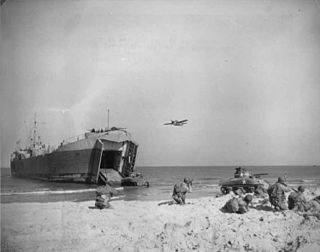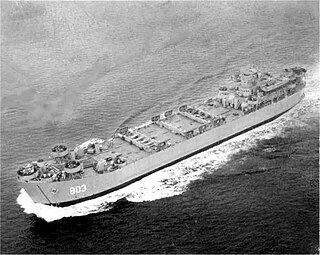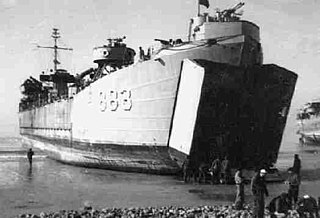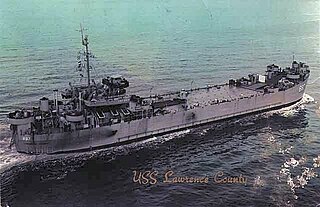
USS Mahoning County (LST-914) was an LST-542-class tank landing ship built for the United States Navy during World War II. Like many of her class, she was not named and is properly referred to by her hull designation. She was later named after Mahoning County, Ohio, she was the only US Naval vessel to bear the name.

USS Luzerne County (LST-902) was an LST-542-class tank landing ship built for the United States Navy during World War II. Named after Luzerne County, Pennsylvania, she was the only U.S. Naval vessel to bear the name.

USS Orange County (LST–1068) was an LST-542-class tank landing ship built for the United States Navy during World War II. Unlike many of her class, which received only numbers and were disposed of after World War II, she survived long enough to be named. On 1 July 1955, all LSTs still in commission were named for US counties or parishes; LST-1068 was given the name Orange County, for counties in the states of California, Florida, Indiana, New York, North Carolina, Texas, Vermont, and Virginia, she was the only US Naval vessel to bear the name.

USS San Bernardino County (LST–1110) was an LST-542-class tank landing ship built for the United States Navy during World War II. Named for San Bernardino County, California, she was the only U.S. Naval vessel to bear the name.

USS Berkshire County (LST-288) was an LST-1-class tank landing ship built for the United States Navy during World War II. Named for Berkshire County, Massachusetts, she was the only U.S. naval vessel to bear the name.

USS Millard County (LST-987) was an LST-542-class tank landing ship built for the United States Navy during World War II. Named after Millard County, Utah, it was the only U.S. Naval vessel to bear the name.

USS LST-900 was an LST-542-class tank landing ship in the United States Navy during World War II. Late in her career, she was renamed Linn County (LST-900)—after counties in Iowa, Kansas, Missouri, and Oregon—but saw no active service under that name.

USS Pitkin County (LST-1082) was an LST-542-class tank landing ship built for the United States Navy during World War II. Named after Pitkin County, Colorado, she was the only U.S. Naval Vessel to bear the name.

The USS Hampden County (LST-803) was an LST-542-class tank landing ship built for the United States Navy during World War II. Named after Hampden County, Massachusetts, she was the only U.S. Naval vessel to bear the name.
USS LST-850 was an LST-542-class tank landing ship built for the United States Navy during World War II. Late in her career, she was renamed Juniata County (LST-850)—after Juniata County, Pennsylvania, the only U.S. Naval vessel to bear the name—but never saw active service under that name.

USS La Moure County (LST-883) was an LST-542-class tank landing ship built for the United States Navy during World War II. Named after LaMoure County, North Dakota, she was the first of two U.S. naval vessels to bear the name.

USS Lawrence County (LST-887) was a LST-542-class tank landing ship built for the United States Navy during World War II. Named after counties in eleven U.S. states, she was the only U.S. Naval vessel to bear the name.
USS Lyon County (LST-904) was an LST-542-class tank landing ship built for the United States Navy during World War II. Named after counties in Iowa, Kansas, Kentucky, Minnesota, and Nevada, she was the only U.S. Naval vessel to bear the name.

USS Mahnomen County (LST-912) was an LST-542-class tank landing ship built for the United States Navy during World War II. Like many of her class, she was not named and is properly referred to by her hull designation. She was later named after Mahnomen County, Minnesota, and was the only US Navy vessel to bear the name.

USS Monmouth County (LST-1032) was an LST-542-class tank landing ship built for the United States Navy during World War II. Named after Monmouth County, New Jersey, she was the only U.S. Naval vessel to bear the name.
USS LST-1038 was a LST-542-class tank landing ship built for the United States Navy during World War II. She was later named Monroe County (LST-1038) after counties in seventeen U.S. States – the only U.S. Naval vessel to bear the name – but never saw active service under the latter name.

USS Montgomery County (LST-1041) was an LST-542-class tank landing ship built for the United States Navy during World War II. Named after counties in 18 U.S. states, she was the only U.S. Naval vessel to bear the name.

USS Orleans Parish (LST-1069) was an LST-542-class tank landing ship in the United States Navy during World War II. Unlike many of her class, which received only numbers and were disposed of after World War II, she survived long enough to be named. On 1 July 1955, all LSTs still in commission were named for US counties or parishes; LST-1069 was given the name Orleans Parish, after Orleans Parish, Louisiana. She was the only U.S. Naval vessel to bear that name.

USS St. Clair County (LST-1096) was a LST-542-class tank landing ship built for the United States Navy in World War II. Like most of the ships of her class she was originally known only by her designation, USS LST-1096, and, like all remaining LSTs, was renamed on 1 July 1955. She was named for counties in Alabama, Illinois, Michigan, and Missouri.

USS Ringness (APD-100) was a Crosley-class high speed transport that served in the United States Navy from 1944 to 1946. After spending 29 years in reserve, she was sold for scrapping in 1975.
















